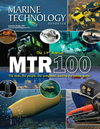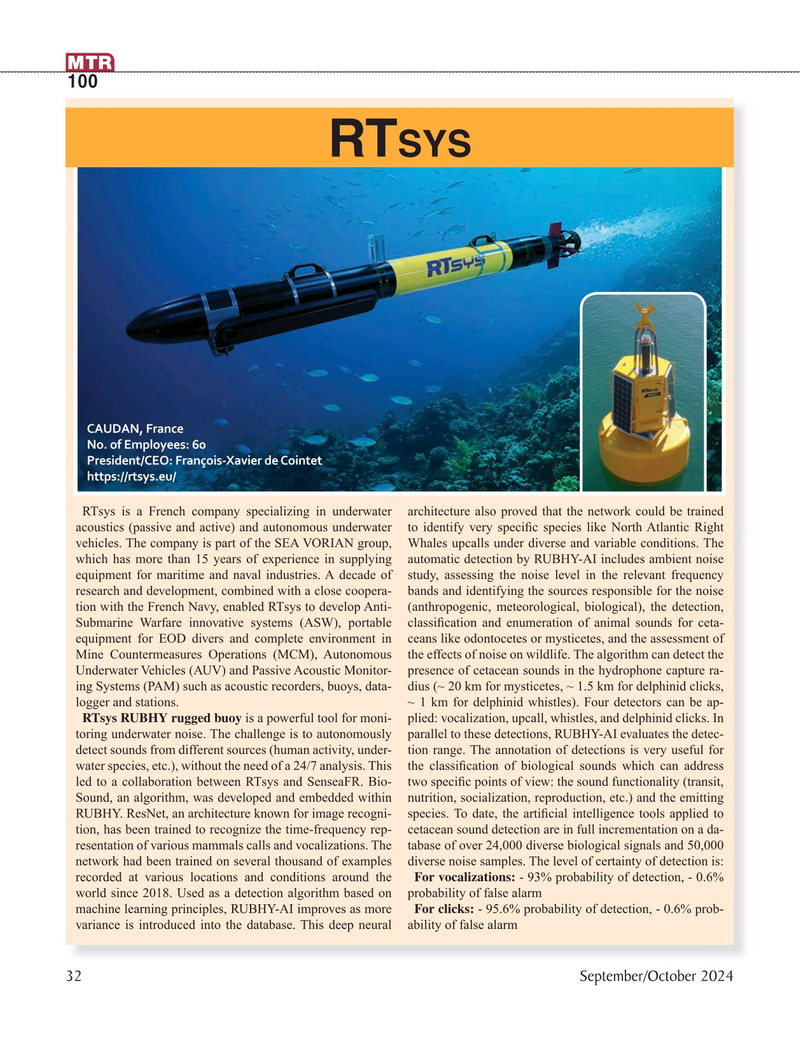
Page 32: of Marine Technology Magazine (September 2024)
Read this page in Pdf, Flash or Html5 edition of September 2024 Marine Technology Magazine
MTR 100
RT SYS
CAUDAN, France
No. of Employees: 60
President/CEO: François-Xavier de Cointet https://rtsys.eu/
RTsys is a French company specializing in underwater architecture also proved that the network could be trained acoustics (passive and active) and autonomous underwater to identify very speci? c species like North Atlantic Right vehicles. The company is part of the SEA VORIAN group, Whales upcalls under diverse and variable conditions. The which has more than 15 years of experience in supplying automatic detection by RUBHY-AI includes ambient noise equipment for maritime and naval industries. A decade of study, assessing the noise level in the relevant frequency research and development, combined with a close coopera- bands and identifying the sources responsible for the noise tion with the French Navy, enabled RTsys to develop Anti- (anthropogenic, meteorological, biological), the detection,
Submarine Warfare innovative systems (ASW), portable classi? cation and enumeration of animal sounds for ceta- equipment for EOD divers and complete environment in ceans like odontocetes or mysticetes, and the assessment of
Mine Countermeasures Operations (MCM), Autonomous the effects of noise on wildlife. The algorithm can detect the
Underwater Vehicles (AUV) and Passive Acoustic Monitor- presence of cetacean sounds in the hydrophone capture ra- ing Systems (PAM) such as acoustic recorders, buoys, data- dius (~ 20 km for mysticetes, ~ 1.5 km for delphinid clicks, logger and stations. ~ 1 km for delphinid whistles). Four detectors can be ap-
RTsys RUBHY rugged buoy is a powerful tool for moni- plied: vocalization, upcall, whistles, and delphinid clicks. In toring underwater noise. The challenge is to autonomously parallel to these detections, RUBHY-AI evaluates the detec- detect sounds from different sources (human activity, under- tion range. The annotation of detections is very useful for water species, etc.), without the need of a 24/7 analysis. This the classi? cation of biological sounds which can address led to a collaboration between RTsys and SenseaFR. Bio- two speci? c points of view: the sound functionality (transit,
Sound, an algorithm, was developed and embedded within nutrition, socialization, reproduction, etc.) and the emitting
RUBHY. ResNet, an architecture known for image recogni- species. To date, the arti? cial intelligence tools applied to tion, has been trained to recognize the time-frequency rep- cetacean sound detection are in full incrementation on a da- resentation of various mammals calls and vocalizations. The tabase of over 24,000 diverse biological signals and 50,000 network had been trained on several thousand of examples diverse noise samples. The level of certainty of detection is: recorded at various locations and conditions around the For vocalizations: - 93% probability of detection, - 0.6% world since 2018. Used as a detection algorithm based on probability of false alarm machine learning principles, RUBHY-AI improves as more For clicks: - 95.6% probability of detection, - 0.6% prob- variance is introduced into the database. This deep neural ability of false alarm 32 September/October 2024
MTR #7 (18-33).indd 32 10/3/2024 11:39:22 AM

 31
31

 33
33
